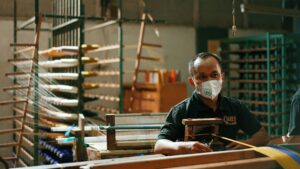Production refers to the process of creating goods or services through various activities and inputs. It involves converting raw materials, resources, and labor into finished products or delivering intangible outputs. The production process typically encompasses several stages, including planning, sourcing, manufacturing, and distribution.
In the context of manufacturing, production entails transforming raw materials into tangible products by utilizing machinery, equipment, and human effort. This process often involves sequential steps such as assembly, fabrication, processing, or refining, depending on the nature of the product. Efficient production techniques, such as automation and lean manufacturing, aim to optimize resource utilization, minimize waste, and enhance productivity.
For service-based industries, production refers to the creation and delivery of intangible offerings to meet customer needs. This can involve activities such as designing, consulting, programming, customer support, or any other service that adds value to the recipient. The service production process often relies on human skills, expertise, and technology to provide solutions and fulfill customer expectations.
In both manufacturing and service sectors, production is driven by factors such as demand, supply chain management, quality control, efficiency, cost-effectiveness, and customer satisfaction. Effective production management involves strategic decision-making, resource allocation, capacity planning, scheduling, and continuous improvement efforts to optimize operations and achieve desired outcomes.
Overall, production encompasses the entire lifecycle of creating goods or delivering services, from concept development and sourcing of inputs to the final delivery or consumption by customers. It plays a crucial role in economic growth, job creation, and meeting consumer demands by providing the goods and services essential for our daily lives.
In the context of design, production refers to the phase or process of turning design concepts or ideas into tangible or functional outputs. It involves the implementation and execution of design plans, specifications, and prototypes to create a final product, system, or solution.

Production in design can encompass various aspects depending on the specific field or discipline. For example:
-
Industrial Design: In industrial design, production involves the transformation of product designs into physical prototypes or manufactured goods. It includes activities such as selecting appropriate materials, refining design details for manufacturability, creating technical drawings or specifications, and collaborating with manufacturers to ensure the accurate and efficient production of the designed products.
-
Graphic Design: In graphic design, production involves the preparation of design assets for reproduction or distribution. This can include tasks such as finalizing layouts, selecting color palettes, optimizing images for print or digital media, and ensuring consistency in design elements across different mediums.
-
Web Design: In web design, production involves the process of developing and building websites based on design concepts. It includes tasks such as coding HTML/CSS, creating interactive elements, integrating content management systems or e-commerce platforms, and testing the functionality and responsiveness of the website across various devices.
-
Architectural Design: In architectural design, production involves translating architectural plans and drawings into physical structures. It encompasses activities such as coordinating with contractors and builders, overseeing construction processes, selecting and sourcing building materials, and ensuring compliance with building codes and regulations.
In all these design disciplines, production is the phase where the design is brought to life, whether it’s through manufacturing, printing, coding, or construction. It requires collaboration with various stakeholders, such as manufacturers, fabricators, developers, or contractors, to ensure the successful realization of the design vision. Effective production management in design involves considering factors like cost, quality control, feasibility, sustainability, and meeting client or user requirements.
In conclusion, production in design signifies the crucial phase where design concepts are transformed into tangible or functional outputs. Whether it’s in industrial design, graphic design, web design, or architectural design, production involves the implementation and execution of design plans, specifications, and prototypes to create the final product, system, or solution.
Production in design requires a collaborative effort with various stakeholders, including manufacturers, fabricators, developers, or contractors. It necessitates careful consideration of factors such as cost, quality control, feasibility, sustainability, and meeting client or user requirements.
The production phase plays a vital role in ensuring the successful realization of the design vision. It bridges the gap between design concepts and tangible results, allowing designs to come to life and fulfill their intended purpose. Effective production management in design requires attention to detail, technical expertise, and coordination to ensure accurate implementation and efficient manufacturing or construction processes.
By understanding the significance of production in design, designers can optimize their creative process, enhance collaboration with production partners, and ultimately deliver high-quality, functional, and aesthetically pleasing outcomes.